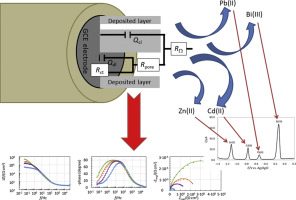当前位置:
X-MOL 学术
›
Anal. Chim. Acta
›
论文详情
Our official English website, www.x-mol.net, welcomes your
feedback! (Note: you will need to create a separate account there.)
A detailed electrochemical impedance spectroscopy study of a bismuth-film glassy carbon electrode for trace metal analysis
Analytica Chimica Acta ( IF 5.7 ) Pub Date : 2018-04-01 , DOI: 10.1016/j.aca.2017.12.020 Barbara Petovar , Klodian Xhanari , Matjaž Finšgar
Analytica Chimica Acta ( IF 5.7 ) Pub Date : 2018-04-01 , DOI: 10.1016/j.aca.2017.12.020 Barbara Petovar , Klodian Xhanari , Matjaž Finšgar

|
A systematic electrochemical impedance spectroscopy (EIS) analysis at different potentials of an in situ-prepared bismuth-film glassy carbon electrode (BiFE) in 0.1 M acetate buffer solution is reported. This electrode is employed in the square-wave anodic stripping voltammetry (SWASV) technique for the determination of trace amounts of the heavy metals Zn, Cd, and Pb. The method was first validated for detection limit, linear range, sensitivity, precision and accuracy to clearly prove the superior action of BiFE compared with the bare glassy carbon electrode (GCE). Next, in order to investigate the characteristics of this sensor, EIS measurements were carried out at slightly more negative potentials than the potentials at which each individual stripping signal is detected, after the deposition step at different deposition potentials. For comparison, EIS measurements were also performed at open circuit potential. The studied trace metal concentration range (5-20 ppb) did not significantly influence the capacitive and resistive behaviour of the BiFE which explains why the performance of this sensor is superior compared with the bare GCE. The higher sensitivity of the SWASV method for BiFE compared with the bare GCE was explained by the lower polarisation resistance values of the former. Moreover, the potential of zero charge was also determined, and an explanation whether the system is under kinetic- and/or diffusion-controlled process is given.
中文翻译:

用于痕量金属分析的铋膜玻璃碳电极的详细电化学阻抗谱研究
报道了在 0.1 M 醋酸盐缓冲溶液中原位制备的铋膜玻璃碳电极 (BiFE) 在不同电位下的系统电化学阻抗谱 (EIS) 分析。该电极用于方波阳极溶出伏安法 (SWASV) 技术,用于测定痕量的重金属 Zn、Cd 和 Pb。该方法首先在检测限、线性范围、灵敏度、精密度和准确度方面进行了验证,以清楚地证明 BiFE 与裸玻碳电极 (GCE) 相比具有优越的作用。接下来,为了研究该传感器的特性,在不同沉积电位的沉积步骤之后,在比检测到每个单独的剥离信号的电位略高的负电位下进行 EIS 测量。为了进行比较,还在开路电位下进行了 EIS 测量。研究的痕量金属浓度范围 (5-20 ppb) 没有显着影响 BiFE 的电容和电阻行为,这解释了为什么该传感器的性能优于裸 GCE。与裸 GCE 相比,SWASV 方法对 BiFE 的灵敏度更高,原因是前者的极化电阻值较低。此外,还确定了零电荷电位,并解释了系统是否处于动力学和/或扩散控制过程中。研究的痕量金属浓度范围 (5-20 ppb) 没有显着影响 BiFE 的电容和电阻行为,这解释了为什么该传感器的性能优于裸 GCE。与裸 GCE 相比,SWASV 方法对 BiFE 的灵敏度更高,原因是前者的极化电阻值较低。此外,还确定了零电荷电位,并解释了系统是否处于动力学和/或扩散控制过程中。研究的痕量金属浓度范围 (5-20 ppb) 没有显着影响 BiFE 的电容和电阻行为,这解释了为什么该传感器的性能优于裸 GCE。与裸 GCE 相比,SWASV 方法对 BiFE 的灵敏度更高,原因是前者的极化电阻值较低。此外,还确定了零电荷电位,并解释了系统是否处于动力学和/或扩散控制过程中。
更新日期:2018-04-01
中文翻译:

用于痕量金属分析的铋膜玻璃碳电极的详细电化学阻抗谱研究
报道了在 0.1 M 醋酸盐缓冲溶液中原位制备的铋膜玻璃碳电极 (BiFE) 在不同电位下的系统电化学阻抗谱 (EIS) 分析。该电极用于方波阳极溶出伏安法 (SWASV) 技术,用于测定痕量的重金属 Zn、Cd 和 Pb。该方法首先在检测限、线性范围、灵敏度、精密度和准确度方面进行了验证,以清楚地证明 BiFE 与裸玻碳电极 (GCE) 相比具有优越的作用。接下来,为了研究该传感器的特性,在不同沉积电位的沉积步骤之后,在比检测到每个单独的剥离信号的电位略高的负电位下进行 EIS 测量。为了进行比较,还在开路电位下进行了 EIS 测量。研究的痕量金属浓度范围 (5-20 ppb) 没有显着影响 BiFE 的电容和电阻行为,这解释了为什么该传感器的性能优于裸 GCE。与裸 GCE 相比,SWASV 方法对 BiFE 的灵敏度更高,原因是前者的极化电阻值较低。此外,还确定了零电荷电位,并解释了系统是否处于动力学和/或扩散控制过程中。研究的痕量金属浓度范围 (5-20 ppb) 没有显着影响 BiFE 的电容和电阻行为,这解释了为什么该传感器的性能优于裸 GCE。与裸 GCE 相比,SWASV 方法对 BiFE 的灵敏度更高,原因是前者的极化电阻值较低。此外,还确定了零电荷电位,并解释了系统是否处于动力学和/或扩散控制过程中。研究的痕量金属浓度范围 (5-20 ppb) 没有显着影响 BiFE 的电容和电阻行为,这解释了为什么该传感器的性能优于裸 GCE。与裸 GCE 相比,SWASV 方法对 BiFE 的灵敏度更高,原因是前者的极化电阻值较低。此外,还确定了零电荷电位,并解释了系统是否处于动力学和/或扩散控制过程中。











































 京公网安备 11010802027423号
京公网安备 11010802027423号